Traduzindo...
Este artigo está em processo de tradução. Você pode contribuir editando ele.
|

Bandeira pré-guerra do Estados Unidos
Os Estados Unidos da Améroca (em inglês: United States), foram uma república federativa e uma das maiores potências militares e econômicas antes da Grande Guerra, assim como também uma das últimas nações sobreviventes da crise energética da metade de século XXI. O país situava-se principalmente na região central da América do Norte, fazendo fronteira com o Canadá no norte e com o México no sul. O estado do Alasca estava no noroeste do continente, fazendo fronteira com o Canadá no leste e com a Rússia. A maior parte do território foi completamente destruído durante o holocausto nuclear provocado pela Grande Guerra em 23 de Outubro de 2077.
Apesar de destruído, os Estados Unidos permaneceu sendo habitado por uma grande quantidade de pessoas, espalhadas em comunidades, vilas e até mesmo grande cidades, mesmo que estas em ruínas. Com o colapso do Governo Federal dos Estados Unidos da América, houve o surgimento de diversas facções, como a New California Republic, Brotherhood of Steel e principalmente o Enclave, que são considerados os remanescentes do governo.
As Comunidades Americanas
Antes da Grande Guerra em 2077, os Estados Unidos no universo de Fallout tem um level de governo intermediário entre os cinquentas estados e o governo federal. A nação foi dividida entre trinta comunidades (no original, Commonwealths) de autogoverno algum tempo depois do fim da II Guerra Mundial em 1945 e antes da missão Virgo II ter aterrissado americanos na Lua em julho de 1969. A bandeira dos Estados Unidos mudou para refletir a nova realidade política. Portanto, a nova bandeira mostra quatorze estrelas - treze em um círculo para representar as comunidades e uma no meio para representar o Governo Federal e a nação por inteiro. Era esperada que essa nova divisão administrativa do país ajudasse na criação de uma legislação ampla o suficiente para beneficiar esses estados com preocupações regionais comuns, mas estreito suficiente para não afetar essas comunidades com interesses diferentes ou culturas políticas, que ajudaria a nação contra os desafios da ameaça comunistas na democracia americana. Na realidade, foi criado mais pelo conflito político no governo americano, já que as comunidades tipicamente fariam tudo que eles quisessem para promover seus interesses à expansão das outras comunidades. As treze comunidades americanas eram:
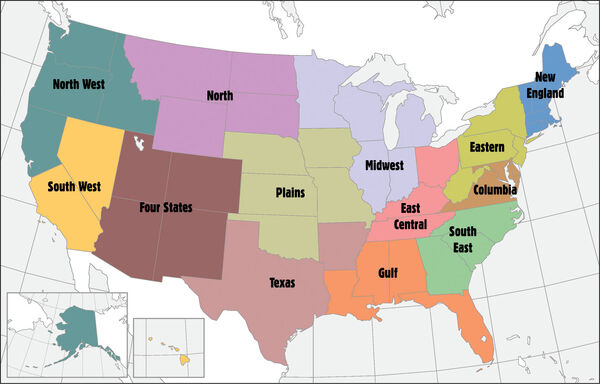
Mapa das Comunidades
| O seguinte é baseado J.E. Sawyer's Fallout RPG e {{{1}}}. |
| Comunidades | Cor | Estados |
|---|---|---|
| Columbia | Vermelho | Washingt
|
| East Central | Azul marinho | Ohio, Kentucky, Tennessee |
| Eastern | Amarelo | West Virginia, Delaware, Pennsylvania, New Jersey, New York |
| Four States | Verde | Utah, Colorado, Arizona, New Mexico |
| Gulf | Rosa | Louisiana, Mississippi, Alabama, Florida |
| Midwest | Cinza | Wisconsin, Minnesota, Illinois, Indiana, Michigan |
| New England | Verde água | Maine, New Hampshire, Vermont, Massachusetts, Rhode Island, Connecticut |
| North | Laranja | Montana, Wyoming, North Dakota, South Dakota |
| Northwest | Roxo | Northern California, Washington, Oregon, Idaho, Alaska |
| Plains | Amarelo pastel | Nebraska, Kansas, Iowa, Missouri, Oklahoma |
| Southeast | Cinza claro | Georgia, South Carolina, North Carolina |
| Southwest | Azul pastel | Southern California, Nevada, Hawaii |
| Texas | Black | Texas, Arkansas |
| Fim das informações baseadas J.E. Sawyer's Fallout RPG |
Canadá
É desconhecido se houve alguma mudança no sistema de comunidades depois do anexo do Canadá em 2076. É possível que o Canadá estivesse em domino militar antes de o anexo ser finalizado em 2076. Por causa do relativamente pequeno tamanho da população, o Canadá era igual em tamanho a uma única grande comunidade americana. Mudanças na fronteira eram possíveis, por exemplo, o Alaska e as linhas de tubulações.
México
O Exército dos EUA invadiu o México, em 2051, para o anexar, querendo os seus interesses comerciais e o fornecimento de petróleo, mas um consenso sobre os objetivos da guerra nunca foi alcançado.
Governo Federal
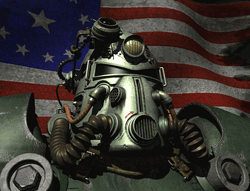
A United States soldier in Power Armor in front of the U.S. flag.
O governo federal pré-guerra dos Estados Unidos não era tão diferente do governo do século 20 de nosso universo, embora que com certas diferenças. Duas das agências do governo federal que são são mencionadas nos jogos (mais focadas em assuntos militares): o Departamento de Guerra (War Department) e o Departamento de Defesa (Department of Defense), que podem ter sido realmente a mesma agência, ou, também poderiam ser entidades separadas (não é deixado muito claro), mas é certo que foram ambass responsáveis por supervisionar o desenvolvimento de diversos projetos e pesquisa militares, do HERMES ao West Tek's T-51b Power Armor.
Outras agências federais mencionadas nos jogos são o Departamento de Energia (Department of Energy (de água e/ou energia)). O Federal Bureau of Investigation (FBI), Unamerican Activities Force, Secret Service, Bureau of Alcohol, Drugs, Tobacco, Firearms and Lasers e o United States Space Administration. O poder legislativo do governo federal ainda foi composto pela Câmara dos Deputados (House of Representatives) e do Senado, embora se eles ainda representaram os estados individuais ou agora representado as diferentes repúblicas americanas, de alguma forma é desconhecida.
Forças Armadas
Antes da Grande Guerra, as Forças Armadas dos Estados Unidos eram a união de todas as forças militares dos Estados Unidos, composta pelo Exército, Corpo da Marinha, Marinha, Guarda Costeira e Força Aérea. O presidente dos Estados Unidos serviu como chefe de comandante-chefe dos militares americanos, com o Ministério da Guerra (às vezes chamado de Ministério da Defesa) atuando como principal orgão que a política militar atuava.
Depois da Grande Guerra, as Forças Armadas Enclave são descendentes diretos do exército americano. A Brotherhood of Steel (Irmandade do Aço), no outro lado, foi iniciada por soldados do exército americano que se rebelaram contra as ordens antiéticas para proteger cientistas que realizavam experimentos de mutação em prisioneiros militares contra a vontade desses.
The Enclave
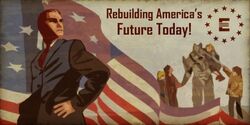
Enclave propaganda poster.
Members of the Enclave both embraced th
e idea of a nuclear war and knew that the common man could not survive it. They believed that as long as the "important people" of the United States survived, they could regroup quickly and wipe out Communism once and for all. Though not technically part of the Enclave, many powerful corporations benefited from the Enclave’s actions, and their research facilities were protected during the nuclear firestorm of 2077.
In 2073, as the global race to exploit the handful of remaining fossil-fuel resources reached its fevered peak, the United States managed to stake a claim on the world's last known supply of crude oil, buried thousands of feet beneath the Pacific Ocean. Poseidon Energy, a major American energy company, was contracted to build an oil rig and extract the oil. Before long, the oil ran dry and the oil rig was abandoned by Poseidon.
In 2077, with total nuclear war imminent, the President of the United States and a number of other American government officials left their posts in Washington, DC to take refuge in a number of secret locations around the world. Among them was the Poseidon Oil Rig off the coast of California. Here, the president himself set up a secret base from which the United States could continue to exist and wage war on China, with the eventual goal of retaking the continental United States from its post-atomic state. From 2077 on, the remnant of the American government surviving on this oil rig started to openly call itself the Enclave. In diolouge with Arcade Gannon, in Fallout New Vegas it is revealed that after the Fall of the Oil Rig, the NCR eventually overran Navarro. This caused all Enclave forces in the west to Scatt
er to the east. Furthermore with the destruction of Raven Rock and Adams Air Force base, unless there are other bases (Chicago is mentioned in the audio logs during ED-E My Love), for the time being the Enclave is effectively crippled.
The Enclave mostly continued the pre-War American government, making alterations to fit their smaller size and increase the fluidity of operations. Some new departments that were established after the Great War included the Atomic Energy Commission and the Chemical Corps.
History
Pre-Great War
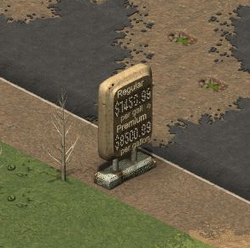
US gas prices in 2077 (per gallon):
Regular - $7450.99
Premium - $8500.99
Ever since the end of World War II in 1945, the United States in the Fallout universe had sought to become the sole remaining superpower in the world, aiming to control the globe's major energy resources and influence the direction of life in other nations. In the twenty-first century this trend became even more apparent, because, as the Resource Wars raged between the European Commonwealth and the oil-rich states of the Middle East, and as the United Nations disbanded in acrimony, the United States found itself with no real rival on the global scene...except the People's Republic of China, which had become the second largest economy in the world.
However, the energy crisis of the mid-twenty-first century hit the United States harder than expected, coupled with the outbreak of the New Plague in 2053. In 2054 a nuclear exchange in the Middle East prompted the American government to establish Project Safehouse, which was intended to create 122 underground shelters that would save a select portion of American society from the ravages of nuclear war or an unstoppable global pandemic. Five years later, in 2059, in order to protect its Alaskan oil interests, the United States established the Anchorage Front Line, to defend its stockpiles of oil from potential invaders.
In 2060, as stockpiles of oil ran dry and the last underground reservoirs of petroleum emptied, the American economy ground to a halt. People stopped traveling by car and the political pressure to research alternative sources of energy increased enormously. To maintain its status as a superpower in spite of the crisis, the United States expanded the size of its military and commissioned a government defense contractor, West Tek to create powered infantry armor, which was intended to replace tanks on the battlefield. This
project eventually proved to be the salvation of American industry, and, in the summer of 2066, the first crude nuclear fusion cell was developed as part of this research effort and was then adopted to civilian needs.
This fact, coupled with American unwillingness to share the world's last untapped oil field in the Pacific Ocean with other energy-starved nations, prompted China to declare open war against the United States and invade
Alaska in 2066, initiating the Sino-American War. The initial Chinese campaign was successful, but soon, Chinese and American soldiers found themselves bogged down in a war of attrition, with both sides unable to gain any sort of meaningful advantage over the other. Even the mighty American T-45d Power Armor units did not tip the scales, as China's Crimson Dragoon units rampaged behind American lines, disrupting the U.S. Army's logistics and transport.
The United States' northern neighbor, Canada, proved unwilling to accept the increasingly aggressive behavior of the United States as it fought to repel the Chinese invasion. Faced with almost open hostility and the threat of military action, Ottawa relented, allowing American troops and aircraft to pass freely through its territory. This led directly to the annexation of Canada by the United States in 2076.
War and the energy crisis took a toll on American citizens. Together with the development of the Forced Evolutionary Virus (FEV) being leaked to the mainstream news, 400 million citizens became increasingly restless as the global and national situation deteriorated, throwing the country into turmoil. The U.S. Army was deployed into major American urban centers to contain riots in the year just before the Great War, leading to the American Army firing on its own citizens in certain circumstances.
All these events became meaningless in 2077, as the atomic holocaust wiped the slate clean, engulfing the world in flames and destroying human civilization.
América Pos-Guerra
However, as fate would have it, humanity survived the atomic catastrophe. Even the American federal government managed to survive and became the Enclave, the only known remnant of the pre-War government.
Surviving American citizens, particularly in what had once been the state of California, soon started rebuilding and eventually established the New California Republic.
The USA will be habitable by 2377, as stated in the Vault 101 PA System.
A Bandeira
Cowpens Flag
Os Estados Unidos da cronologia de Fallout, pelo menos desde a formação dos treze commonwealths americanos na metade do século XX, usa uma bandeira com 12 ou 13 estrelas em um padrão circular, com uma grande estrela central.
Apesar de a versão final do Fallout 3 com 12 estrelas circundando uma 13ª lembrar mais uma bandeira obscura conhecida como "Cowpens Flag", a bandeira com um círculo de estrelas mostrado na abertura cinemática de Fallout é consideravelmente mais conhecida, a Bandeira de 'Betsy Ross'. Uma bandeira com 13 estrelas e listras, uma para cada um dos estados originais dos EUA, foi estabelecida pela Second Continental Congress' Flag Resolution of 1777 ("Segunda Resolução da Bandeira do Congresso Continental de 1777). Enquanto estados eram adicionados à União, mais estados eram adicionados à bandeira até a bandeira de 50 estrelas ter sido criada em 1960.
A "Cowpens Flag" era uma bandeira americana revolucionária pré-guerra usada na Batalha de Cowpens, South Carolina, em 1781, que resultou em uma das maiores vitórias da jovem nação sobre sua pátria-mãe britânica. A única diferença entre a "Cowpens" e as bandeiras de Fallout é a estrela central usada na bandeira americana no universo Fallout, provavelmente para representar a nação como um todo.
Aparições
O legado dos Estados Unidos aparece em todos os jogos da série Fallout, sendo que os jogos se passam onde antes era seu território.
Behind the scenes
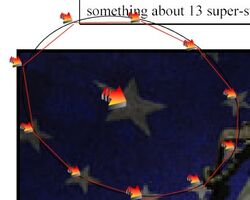
Red's "correction".
The initial idea of dividing the country into thirteen zones came from Leonard Boyarsky during the development of Fallout. In Fallout Bible 8 Tim Cain reported that Leon said he used that flag because it looked cool and he didn't want to use a standard U.S. flag with 50 stars. Eventually he planned to make up something about 13 super-states or something, but he never did. It was further elaborated upon by J.E. Sawyer, who broke up the U.S. into Commonwealths.
There is much misunderstanding about the number of stars on the flag and the corresponding zones, because not all of them are actually visible in the only available picture depicting it. Chris Avellone stated that there are 13 of them in Fallout Bible 8. He was "corrected" by Red, who sent him the picture with the location of 11 stars marked. In 2005, J. E. Sawyer tried to clarify the issue by saying that according to Tramell Ray Isaac, who rendered the intro cinematic for Fallout said that they just took the old colonial flag with 13 stars in a circle and added a new star in the middle.
Sawyer's explanation was widely accepted until 2008, when Bethesda Softworks released Fallout 3, which features a flag with 12 stars in a circle and one in the middle, which is currently the only version of the flag fully seen in a released game.
Predefinição:Navbox pre-war countries {C}
